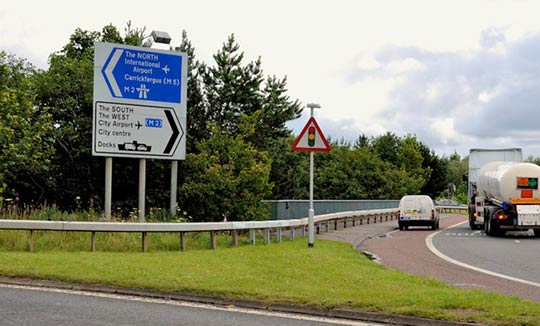
Let's be honest: the Highway Code probably isn't imprinted in your mind in quite the way it should be. If you're older than 35, you didn't have to take a theory test to get your driving licence. Or perhaps you did take it, but that knowledge is now a distant memory. Maybe your test is coming up, and you think things like road signs just aren't that important…
But if you know how to interpret signs instinctively, navigating the roads becomes easier than ever before.
Luckily, we're here to give you some simple hacks to understanding the highway. If you know what to expect, there will be fewer surprises while you're behind the wheel. Road signs are colour-coded, and the shapes are here to help you get the message at a glance.
Circles = orders
Red circles = prohibitions
If you see a circular sign with either a red ring or circle, it's telling you to stop, slow down, not enter or do some other kind of activity. These are regulatory signs, so include speed limits (the number will be the maximum speed) and signs which prohibit types of vehicle on a certain road – e.g. a circular sign with a red ring and a picture of a horse being ridden, it means that no accompanied horses are allowed to continue.
Blue circles = instructions
Blue circular signs give a positive instruction. They often feature arrows, instructing drivers to follow the direction suggested. Examples of this type of sign include mini-roundabout signs, one-way traffic signs, and keep left or right signs.
Triangles = warnings
Triangle signs – usually white with a red border – are here to let you know that you're approaching a hazard or a place to stop. They will usually point upwards and feature an image of the hazard: merging traffic, a junction on a bend, a slippery road or a zebra crossing are all examples of common warning road signs. An exclamation mark in a triangular sign means 'other danger' and will describe the hazard on a white sign below – a hidden dip will be presented like this, for example.
EXCEPTION: While most triangular signs are warnings, not all warnings are triangular. Red rectangles contain warnings, too – so watch out for these particularly if you're in an area you don't know well.
Rectangles = information and directions
Blue rectangles = information or motorway directions
Most blue rectangular signs indicate a motorway. They will often feature directions, distances to destinations, or some other information such as distance until a junction. It's important to identify motorways from other roads, as other driving laws apply to these kinds of road.
Green rectangles = directions on primary routes
These signs provide directions on primary routes – also known as A-roads. Destination names will be in white, while the route numbers will be in yellow.
White rectangles = directions on non-primary routes
Roads that are neither motorways nor primary routes will feature white direction signs with black lettering. If you're expecting to be on a primary route and see one of these signs – think about checking your Sat-Nav!
Brown arrow signs = tourist destinations
Popular destinations are shown on brown signs with white writing. They are shown using either symbols or words – an elephant symbol will mean zoo, for example. The signs also usually show direction and distance.
Exceptions
Black sign with white chevrons
These signs are typically found on bends or some roundabouts. Depending on whether it points left or right, this sign indicates a sharp bend in the direction in points. This would usually be seen on a blue sign, but its difference indicates that the bend is sharper, or that it is in a place where a larger, more obvious sign is needed (such as a national speed limit road).
Yellow signs = emergency diversions or temporary checks
Small yellow signs show traffic diversions. These are often temporary signs, but in case of longer-term diversion, a small yellow symbol can be added to a larger directions sign. A symbol is attached to each diversion – a black diamond shape on a yellow background, for example – to ensure that you are following the correct diverted route. Yellow signs can also be used as temporary signs for vehicle checks.
For a more in-depth guide to road signs, gov.uk has a handy PDF guide.
Do you find road signs easy to understand? Would a simpler system make it better for you? Let us know in the comments below!

